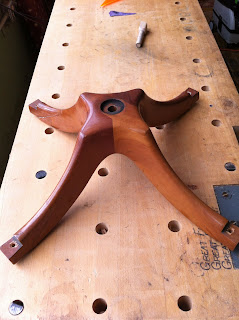
Even after spending as much time as I did on tracing a 3-d shape into 2-D patterns, and even after all the time I spent getting the mating faces and miters cut perfectly, shaping this chair base has turned a lot of things upside down. The entirety of the thing is made up of complex curves, but there are ways to lay those out, if you have precise reference surfaces to work from. But once I'd sawn rough shapes in two dimensions out of the blanks, there wasn't a lot that I could do to hold everything in place on a router table or shaper. That's not to say that I didn't try, but the harder I tried to force the process to work, the less it worked. I had roughly sawn blanks, but I couldn't get the precise reference surfaces that I wanted.
 14 years ago, I worked for a company in Houston that provided Remote Operated Vehicles for offshore use in the Gulf of Mexico, and around the world. The vehicles were basically robotic submarines, connected to the ships and/or oil rigs with long tether cables, and piloted by operators on the surface. Operators 'flew' these remotely operated submarines remotely, and operated the robotic arms when required. Some of the more advanced models had various functions that are roughly analogous to cruise control, including a position holding function. Because he loved his cruise control, and the ease of use that it allowed him, one of my co-workers leisurely announced one day that "I'm a Cadillac Man, you know?"
14 years ago, I worked for a company in Houston that provided Remote Operated Vehicles for offshore use in the Gulf of Mexico, and around the world. The vehicles were basically robotic submarines, connected to the ships and/or oil rigs with long tether cables, and piloted by operators on the surface. Operators 'flew' these remotely operated submarines remotely, and operated the robotic arms when required. Some of the more advanced models had various functions that are roughly analogous to cruise control, including a position holding function. Because he loved his cruise control, and the ease of use that it allowed him, one of my co-workers leisurely announced one day that "I'm a Cadillac Man, you know?" One day, a job called for more accurate position holding than the computer could really handle, given changing currents and computer processing speeds. (This was 1998.) Cadillac Man told the boss it couldn't be done. Someone else stepped up, and said he thought he could pilot the sub well enough to do what had to be done... And so he did. Cadillac Man left the control room in shame. He'd traded aspiration to skill for reliance on machines.
One day, a job called for more accurate position holding than the computer could really handle, given changing currents and computer processing speeds. (This was 1998.) Cadillac Man told the boss it couldn't be done. Someone else stepped up, and said he thought he could pilot the sub well enough to do what had to be done... And so he did. Cadillac Man left the control room in shame. He'd traded aspiration to skill for reliance on machines.  I spent so much time messing around with patterns, figuring it would be easier for me if the machines could give me the reference surfaces that I wanted. I wanted identically smooth surfaces, and I didn't want to have to make them myself. This, despite my years at North Bennet, and learning how to do things by hand. And finally something snapped. So I pulled out the drawknives, and spokeshaves, and commenced to make a hell of a mess... and to shape some very attractive chair legs.
I spent so much time messing around with patterns, figuring it would be easier for me if the machines could give me the reference surfaces that I wanted. I wanted identically smooth surfaces, and I didn't want to have to make them myself. This, despite my years at North Bennet, and learning how to do things by hand. And finally something snapped. So I pulled out the drawknives, and spokeshaves, and commenced to make a hell of a mess... and to shape some very attractive chair legs.I gave up on the notion of doing this with precision, because the truth is that even if I'd gotten precisely milled surfaces, there was only so much that this would give me, and sometimes the only way forward, is 'blindly, with doubt and faith.' (I'm NOT the religious type, believe me.) I remember thinking to myself 'Elvis has definitely left the building on this one...' But at the end of the process, it was actually a lot easier, and a lot more controllable.
The not-quite epilogue... I spent part of today sanding down the new legs for the chair that I'm rebuilding. They look good. There are spots here and there that don't look perfect to me, but I'm a neurotic perfectionist sometimes. That's why I'd rather leave it to the machines, it's less nerve wracking. I say not quite, because there are still a few things that need to be done, including inserting dowels into the legs to re-distribute some of the interior stresses, drilling for the seat post, and notching the ends of the legs for the hardware.



